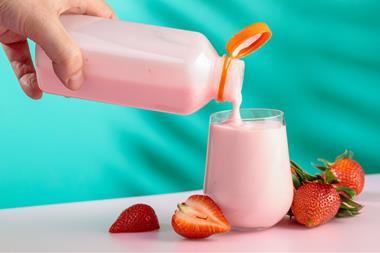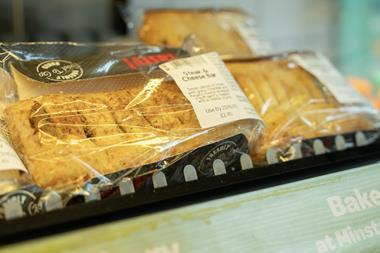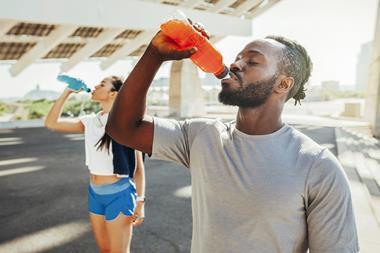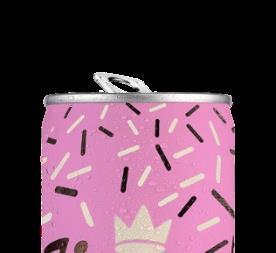Consumers guzzled their way through more than 14 billion litres of soft drinks last year as the total market grew by 5%. For manufacturers the focus was on the increasing demand for healthier choices, which was reflected in the number of new products boasting ’better for you’ credentials.
Against this backdrop forecourts performed well, with value growth ahead of the total market at 6%. Sales of soft drinks through forecourts were worth £258m, which amounted to 15% of the impulse sector, according to Britvic’s Soft Drinks Category Report.
Indeed, soft drinks are the fourth biggest destination category for forecourts according to HIM research - beaten only by newspapers, cigarettes and confectionery. And those customers coming in to buy a soft drink are almost certainly going to be making additional purchases. For example, more than 90% of sandwiches are consumed with a soft drink, says Andrew Marsden, Britvic category director. "This means that retailers should be selling a soft drink with every sandwich," he adds. "If they’re not it means they’ve probably got the wrong selection."
Marsden believes there are two major trends which forecourts should be taking notice of. One is the ’better for you’ trend, but also retailers should not ignore the growth of adult indulgence. "This is particularly important for forecourts as they are a more adult environment. They can really take advantage of this and it’s where the money is," he says. "People going into forecourts are usually in a different mindset, which is more about self-indulgence - what do I want that’s going to get me through this long journey? Therefore they are also prepared to pay a premium, both for the convenience aspect, but also for that sense of indulgence."
Drinks targeted specifically at adults, such as Bottlegreen and Amé, were the second fastest growing category in the total take-home market last year. On forecourts they grew by 9%. However, things like premium juices, smoothies, cola and functional drinks also have strong adult appeal.
Colas remained the biggest sellers on forecourts, worth £69m, but only just as functional drinks grew by 13% to a reach a value of £67m. And reflecting the move towards healthier options, water also saw strong double-digit growth.
Within the functional category, sports and energy drinks remain star performers in forecourts. The two key brands are Red Bull and GlaxoSmithKline’s (GSK) Lucozade, which have continued to drive growth.
Central to Red Bull’s success has been the work it’s done to communicate the benefits of energy drinks in helping drivers to stay alert at the wheel.
A new two-pack has just been launched, designed to encourage consumers to up-weight their purchase. Available in both original and sugar-free variants, the format goes into national cash and carries this month. It follows a successful trial in independent forecourts, which saw up to 32% incremental growth in one month.
GSK has also been building on its success in forecourts with a programme of activity targeting the ’travel’ opportunity. Its Lucozade and Ribena brands are said to have added an incremental £5.6m within the sector last year, and Lucozade Energy original is now available in a 750ml pack aimed specifically at the travel shopper. "Our research revealed that consumers found 1ltr packs difficult to consume during a journey, while 500ml packs did not always last the full trip," explains Craig Mackie, category planning controller at GSK.
Coca-Cola Enterprises has also been busily targeting the booming energy drinks sector with two launches in the past six months. Sprite 3G takes the same 250ml slim can format as Red Bull, but with the refreshing lemon-lime flavour of its parent brand. Launched in October, latest figures show it has already managed to secure a 1.6% value share of the energy drinks sector in forecourts.
Meanwhile, Relentless hit the shelves in February in a bigger 500ml can. The brand is aimed at 18- to 34-year-olds and will be supported by marketing activity themed around action sports and music events.
Also taking a 500ml format, but in a resealable silver bottle is Boost. The brand is said to have grown by 200% since 2003 and is also available in a 1ltr size, in four flavours - original, sugar-free, cranberry and iron brew.
Meanwhile, Barr Soft Drinks has entered the energy sector with Irn-Bru 32. The drink is based on the Scottish favourite’s 32 secret ingredients and is the company’s first product to be introduced UK-wide from launch.
GO WITH THE FLOW
Bottled water was the other big success story in forecourts, with sales hitting £47m. The sector performs well because drivers like to have water with them in the car for long journeys, but the trend towards healthier lifestyles is also fuelling growth.
Steve Flanagan, category strategy manager for Danone Waters, distributors of Volvic and Evian in the UK, says: "We have really seen health trends start to have a major influence on the soft drinks market. Those categories that deliver against these health needs, such as bottled water and fruit juices, are showing strong growth. Within bottled water, we have seen flavoured water show the strongest growth as people look for healthier alternatives to traditional fruit carbonates but still want products to deliver on taste."
Volvic’s Touch of Fruit is currently the leading brand in flavoured water and is said to be growing by 35% year on year. Nestlé Water’s Vittel brand followed Volvic into the flavoured water category last summer and its range has just been relaunched as part of a rebrand for the entire Vittel portfolio.
Aimed at improving visibility on shelf, Deane Ingram, head of commercial performance at Nestlé Waters, says it’s the first major update in many years for the brand. "We’re really pleased with the new packaging and think it’s a massive improvement in communication to the consumer," he says. "We’ve only just started shipping the new designs in the past few weeks - it’s a new bottle shape, a new label and new outer packaging."
Ingram says it’s important for retailers to think about their catchment area and the different needs of the consumers they’re trying to serve. "Forecourts in towns and rural areas should probably focus more on 50cl and 75cl bottle formats," he says. "Out of town, main road and motorway sites - where people are likely to be on longer journeys - should probably focus on the slightly larger formats like the 75cl and 1ltr sports bottles."
Much of the value growth being enjoyed by the water category is said to be fuelled by these larger bottle sizes. To make the most of this, Nestlé’s Buxton brand is launching a 1ltr ’on the move’ bottle. The format has a new thumb-up sports cap, which can be opened one-handed, and goes into stores this month.
Ingram adds that 1.5ltr bottles also sell well on key trunk roads and motorways, where they are particularly popular with van and lorry drivers. However, larger multi-packs of water for in-home consumption are an area where forecourts might be missing out. "They need to make the offering more attractive and encourage consumers," he says. "It’s a massive area for supermarkets and forecourts have an ideal audience. Customers park a lot closer to the store, so getting the packs to the car will be easier."
With sites increasingly looking to attract more top-up grocery shoppers, the multipack opportunity is one that retailers could really take advantage of by offering a good deal.
Premium brand Harrogate Spa has launched one such good deal - its 8x500ml and 6x1.5ltr packs are pricemarked at £1.89 and £2.29 respectively, throughout the summer.
Managing director Paul Martin says the brand has already seen an uplift in multipack sales on forecourts over the past year. "More consumers are choosing to buy bottled water in bulk to satisfy increased consumption requirements as part of a healthier lifestyle," he says. "The price-marked packs provide an excellent opportunity for retailers to capitalise on this and drive sales by stimulating trial."
Another major innovation in the water category has been the launch of Drench by Britvic.
The youth-orientated brand has been in shops since January and Britvic says more than one million litres have been sold since then.
Britvic’s Andrew Marsden, says the brand’s urban positioning and unisex appeal to young adults means it suits forecourts very well. A £2.4m marketing campaign kicked off in April, encouraging drinkers to ’flow your own way’.
Britvic’s water portfolio also includes Pennine Spring, which it acquired in 2004 and relaunched in January. Both this and Drench are UK-sourced products, and this, according to Marsden, is proving a strong selling point in the trade. "From a retailer’s perspective water is a very volatile market, when the weather gets warm consumption expands enormously. The supply chain is very important. Historically some of the other brands haven’t been able to get supplies into the country quick enough because they are based overseas," he explains.
Also based in the UK, Highland Spring has emerged as the fastest-growing top-five bottled water brand, according to a Zenith International report. The brand maintained its third position overall in the UK’s bottled water league table, but has nudged closer to leaders Evian and Volvic. The company has also increased its dominance in the sparkling sector, where it is number one in the UK.
Marketing director Sally Stanley believes the brand has certainly benefited from the public debate on healthier eating and drinking. "More consumers are opting for natural, untouched, authentic products which are increasingly seen as being more beneficial to long-term health and wellbeing," she says.
Highland Spring is promoting its organic credentials in a new television advert, showing nationwide for the first time. Featuring dramatic Scottish landscapes, the commercial captures the journey of the water from rain cloud to bottle and will be shown on all major channels until mid June.
William Watkins, managing director of Welsh mineral water company Radnor Hills, believes provenance has become increasingly important. "Our feedback from retailers shows that people like to know where the ingredients come from. In water this is particularly important, but I think we’ll see this extending throughout drinks in general over the next few years."
The Radnor Hills brand has fully embraced the ’better for you’ trend. Its innovative GI Fruits and GI Fruitades ranges are made only from natural ingredients and have been specially formulated to have a low glycaemic index. It has also launched still juice drink Jufru and refreshed the packaging on its fruit-flavoured water Aqua Splash.
Meanwhile, the ’Jamie Oliver effect’ has also led to a boom in flavoured water aimed at kids, with new products like Britvic’s Fruit Shoot H2O and Buxton’s strawberry splash and lemon wave variants.
FRUIT FIZZ
While health concerns have boosted water sales, changing consumer demands have in turn put pressure on fizzy drinks. Fruit flavoured carbonates had a particularly bad time in forecourts last year, dropping in value by 23%. But it’s not all bad news as the major manufacturers have adapted by offering more sugar-free and diet options, such as Coca-Cola’s Fanta Z range - with Z standing for zero added sugar - and Britvic’s Tango Clear.
And the more refreshing lemon & lime carbonates also had a boost over the summer period, thanks to last year’s good weather.
Britvic’s Andrew Marsden says that innovation has helped re-invigorate the fizzy drinks market and must be supported by retailers. "It’s important to embrace change and offer consumers a wide range of drinks. Diet, low and no sugar drinks continue to rise in popularity and will shape the fortunes of not just fruit-flavoured carbonates, but the entire soft drinks market in the future," he says.
Tango Clear was launched last year with this in mind. Aimed primarily at health conscious 18- to 30-year-olds, Marsden believes the range has strong appeal to forecourt customers. "It’s healthier in the sense it has no added sugar, but it’s also adult-oriented, with an interesting range of flavours."
Cola is also being driven by no added sugar and diet brand extensions and increased its value in forecourts by 6% last year. Both Coca-Cola and Britvic have been busily expanding their respective Diet Coke and Pepsi Max brands into new flavour territories, with recent additions including Diet Coke with Lime, Diet Coke with Cherry, Pepsi Max Twist and Pepsi Max Cino.
GETTING JUICY
Both still fruit drinks and pure juices grew in forecourts last year as consumers sought healthier alternatives.
PepsiCo’s Tropicana was again the number one branded juice in the UK and has been busily targeting the health-conscious consumer with recent launches.
Tropicana Essentials with Benecol is said to help reduce cholesterol, while among four new additions to the Pure Premium range is a blueberry variant, the so-called ’super fruit’. The brand has also launched Tropicana Go, a blend of 70% juice and 30% water aimed at kids. This is available in 1.25ltr and 200ml formats as well as a four-bottle multi-pack aimed at the lunchbox market.
Meanwhile, Del Monte is specifically targeting those on the move with its new Juice Bar range of 100% pure chilled juices. These are said to be ideal for forecourts, particularly as they’re available in a larger 330ml bottle, rather than the more traditional 250ml juice size.
DAIRY DRINKS
The shift away from carbonates is also boosting dairy drinks, which have seen total market growth of 26%.
While not strictly soft drinks, functional products like Yakult, Actimel and Müller Vitality have been particularly successful.
Milkshake brand For Goodness Shakes has tapped into the idea of offering consumers added health benefits in a drink, and its range is enhanced with multi-vitamins and minerals.
Launched specifically in the forecourt sector last year, it is now the UK’s fastest growing milkshake. Initially aimed at men on the move, the brand aims to widen its appeal with the launch of a new superberry flavour this month.
SMOOTH OPERATOR
Although the smallest of the soft drinks sub categories, smoothies was the fastest growing in value last year - up almost 73% across the total market, as volumes almost doubled.
While forecourts actually bucked the trend and saw a decline in sales, this may well have been because smoothies have tended to be under-represented in their chillers.
Innocent is by far the brand leader - three quarters of all the smoothies sold in January of this year were made by the company - and UK sales controller Giles Brook says forecourts are a massive focus area.
He aims to get the brand into a significant number of sites by the end of the year. The company’s salesforce can offer retailers advice on range and merchandising.
PJ Smoothies is the other major name in the market and has just had a £5m relaunch after PepsiCo acquired the brand last year. The 250ml range features eight flavours, including four Super Smoothies, which offer additional functional benefits, such as Energy Boost and Daily Detox. A new 1ltr range has also been added.
FAST FACTS
- Consumers take an average of 11 seconds to choose a soft drink.
- With 55% of soft drinks purchased from forecourts consumed in the car (HIM, CTP), on-the-go formats with sports caps are ideal.
- 70% of soft drinks are bought to be drunk immediately (HIM, CTP).
- EPoS data says that for every degree rise in temperature above 17°C, water sales increase by 6.2%. This means sales will double between 17°C and 29°C so keep an eye on the weather and make sure you have enough stock.
































No comments yet